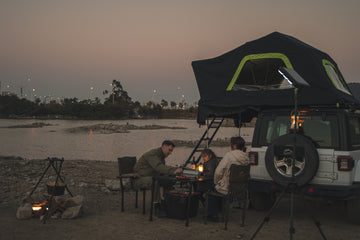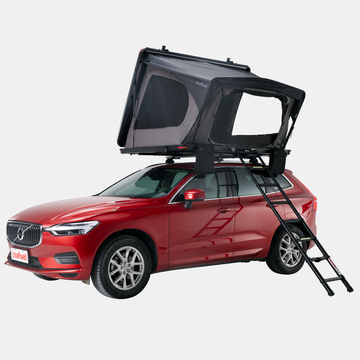
let’s come to second eposide, we mainly discuss with advantage of roof top tent, history and development of roof top tent, also i will let you know the different type of roof top tent.
Firstly, compared the traditional camping tent, what is difference with roof top tent and what is the advantages?
- Good eye sight: it have certain height on the top of car, you can watch further than ground camping tent
- Safety and Comfort: Being elevated provided a measure of safety from wildlife and offered a more comfortable sleeping platform.
- Save space: not occupy the space on the back of car
- Comfortable: it is your mobile home. Have enough big space, not feel muddy and moisturewhen you sleeping inside.
- Easy of setup: Roof tents eliminated the need to find level ground, set up stakes, and deal with uneven terrain.
Development of roof top tent:
The development of rooftop tents (RTTs) has seen significant evolution over the years, transforming from rudimentary homemade designs to innovative, purpose-built camping solutions. Here is a brief overview of the key stages in the development history of rooftop tents:
Early Custom Creations (Mid-20th Century):
In the mid-20th century, camping enthusiasts and overlanders began experimenting with makeshift rooftop sleeping setups. These early designs often involved modifying existing tents to be mounted on the roof of vehicles.
These custom creations aimed to provide a more convenient and elevated camping experience, allowing campers to set up their sleeping quarters quickly without dealing with ground-level obstacles.
Popularity and Commercialization (1970s-1980s):
As recreational camping gained popularity, the demand for convenient camping solutions increased.
In the 1970s and 1980s, some companies recognized the potential market for rooftop tents and started manufacturing and commercializing dedicated products.
These early commercial rooftop tents often featured basic designs with fold-out platforms and canvas walls.
Advancements in Design and Materials (1990s-2000s):
Throughout the 1990s and 2000s, advancements in materials and design contributed to the improvement of rooftop tents.
Lightweight and durable materials, such as aluminum frames and high-quality fabrics, became more widely used, enhancing the overall durability and performance of RTTs.
Innovations like telescoping ladders, easy-to-use mechanisms, and improved aerodynamics made rooftop tents more user-friendly.
Integration with Overlanding Culture (2010s-Present):
The 2010s witnessed a surge in interest in overlanding — self-reliant, vehicle-based adventure travel.
Rooftop tents became integral to the overlanding culture, offering a convenient solution for those traversing varied terrain and seeking spontaneous camping opportunities.
Manufacturers introduced a variety of RTT models, catering to different preferences and needs, such as hardshell rooftop tents, softshell rooftop tents, and hybrid designs.
Innovative Features and Accessories (Present):
In recent years, rooftop tent manufacturers have continued to innovate by introducing features that enhance comfort and functionality. Some RTTs come with built-in mattresses, annex rooms, skylights, and even integrated lighting systems.
Accessories like awnings, annexes, and rooftop storage solutions have become popular additions, creating a complete camping experience.
Expansion of the Market (Present):
The rooftop tent market has expanded globally, with a variety of manufacturers offering diverse options to cater to different vehicle types and camping preferences.
The popularity of rooftop tents extends beyond overlanding, reaching a broader audience of campers who appreciate the convenience and versatility of this camping solution.
The development history of rooftop tents reflects the evolution of camping culture, outdoor adventure, and the desire for a more accessible and comfortable camping experience. As technology and design continue to advance, rooftop tents are likely to see further innovations, making them an integral part of the camping landscape.





